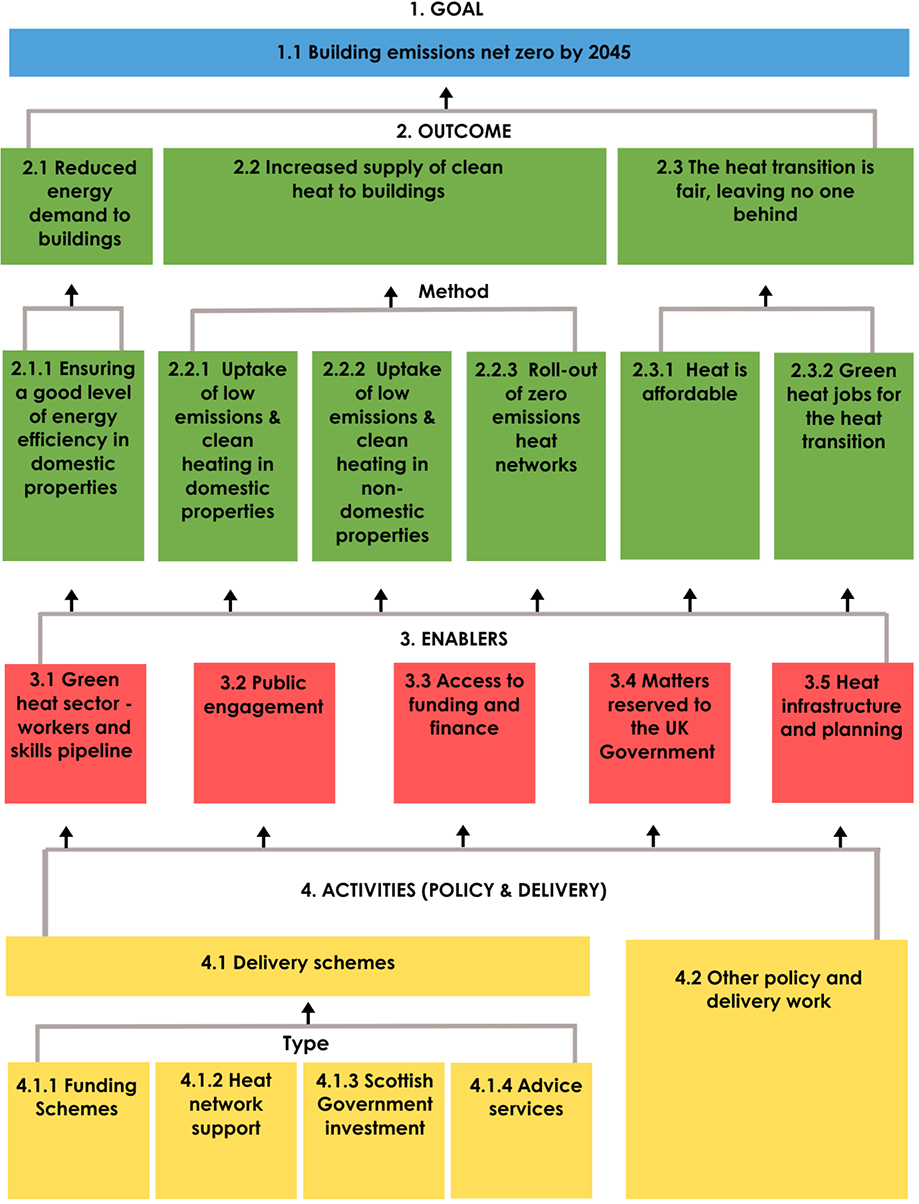Heat in Buildings: progress report 2024
Annual update on progress against our Heat in Buildings Strategy and Monitoring and Evaluation Framework.
Reporting structure
Monitoring map and indicators
We have structured this report around the monitoring map (Figure 1), published in our Monitoring and Evaluation Framework. This was based on the approach used by the CCC. It is designed to show how we expect our policy and delivery activities, supported by ‘enabling factors’, to contribute towards the emissions reduction goal in the Heat in Buildings Strategy[4].
This report is structured with the levels shown in the monitoring map:
- Goal: the overarching target (in this case, to achieve net zero from buildings emissions by 2045)
- Outcome: what the project or activity expects to accomplish, which together bring about the heat transition. The Heat in Buildings Strategy has three outcomes
- Enablers: enabling factors that overcome barriers to achieving outcomes in the Heat in Buildings Strategy
- Activities: Policy and delivery activities that support the enablers of the Heat in Buildings Strategy
In the Framework we described indicators we planned to use to track progress against each level of the monitoring map. This document now includes a numbering system to make it easier to identify each indicator. We also described the data sources we will use to track progress against each indicator, and these are summarised in Annex A. This report presents the best available data against each of the indicators and describes most recent progress.
Baselining and latest data
Where data exist, the baseline position for indicators is 2019. This allows for comparison with a 'typical' year before the Heat in Buildings Strategy was published, prior to coronavirus (COVID-19) in 2020.
The Scottish Household Condition Survey (SHCS) is used for several indicators. The latest SHCS data set is for 2022, with disruption caused by COVID-19 meaning that 2020 data are not available and 2021 is not comparable. Therefore, 2019 provides the most recent data for comparison.
A number of indicators are based on new or emerging data sources, and for these the baseline will be the point at which data are available. Depending on the indicator and data source, most recent data range from 2022 to a date in 2024. We make clear what date this refers to for each indicator.
Data from earlier years (pre-2019) will be presented where this provides useful context.
Limitations
The Framework aims to illustrate the extent to which our policies and programmes are contributing to emission reductions and achieving wider outcomes. We acknowledge, however, that it is not currently possible to directly attribute policy intervention to the impact on outcomes. This is because the Framework cannot capture the effect of all the drivers, especially non-policy drivers, of the heat transition.
Finally, gaps in data make reporting on some areas challenging, particularly heat networks, non-domestic properties, and jobs. However, we provide best available data for indicators and will continue to evolve the Framework by incorporating further data in future reporting as it becomes available.
On non-domestic specifically, work is being undertaken on behalf of the Scottish Government to develop a property based metric to support Heat in Buildings monitoring. This aims to allow us to estimate the number of non-domestic properties with certain heating types.
While we have gone as far as possible to ensure that the data presented are accurate, we may need to update and amend some data post-publication as we continue the process of improvement and verification.

A monitoring map which sets out the relationship between the elements required to deliver the Scottish Government's goal of reducing emissions from Scotland’s buildings as part of a just transition. There are four levels:
1. The 'goal', which is to reduce emissions to net zero by 2045.
2. The 'outcomes', which are: to reduce the energy demand to buildings by ensuring a good level of energy efficiency to buildings, increase the supply of clean heat to both domestic and non-domestic buildings and through the roll-out of heat networks, and the heat transition is fair, leaving no one behind by ensuring heat is affordable and that there are jobs for the heat transition. The outcomes feed into the 'goal'.
3. The 'enablers', which are: a pipeline for green heat sector workers and skills, public engagement, access to funding and finance, matters reserved to the UK Government and heat infrastructure and planning. The 'enablers' feed into the outcomes.
4. The 'activities', which are: the delivery schemes: funding, advice, heat network support and overall Scottish Government investment, and 'other policy and delivery work.'
Contact
Email: heatinbuildings@gov.scot
There is a problem
Thanks for your feedback